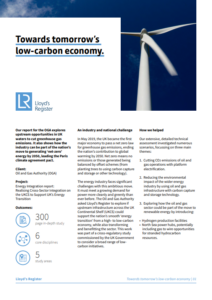Lloyd’s Register conducted a report for the UK’s Oil and gas Authority (OGA) in efforts to explore the country’s upstream opportunities to cut its GHG emissions, amid its announcement in becoming the first major economy to pass a net zero law for greenhouse gas emissions.
Specifically, in May 2019 the UK became the first major economy to enforce a net zero law for GHG emissions.
LR’s study focused on three main scenarios:
- Cutting CO2 emissions of oil and gas operations with platform electrification.
- Reducing the environmental impact of the wider energy industry by using oil and gas infrastructure with carbon capture and storage technology.
- Exploring how the oil and gas sector could be part of the move to renewable energy by introducing:
a)Hydrogen production facilities
b)North Sea power hubs, potentially including gas to wire opportunities for stranded hydrocarbon resources.
Moreover, although it is a preliminary study, LR presents several option for the oil and gas business in the UK. As such:
a) Platform electrification
This method can decrease the oil and gas carbon footprint, while extending asset and field life and improving operational economics.
Also, technical solutions, such as AC and DC systems, are mature and relatively low risk. Commercial solutions are higher risk, as platform retrofits are typically high cost, although requirements vary between platforms and locations.
Supply solutions should ensure that operations have a continuously stable power supply.
Adoption in the UKCS generally needs to be within the next 20 years, but potentially longer in the under explored, growth area of West of Shetland (WoS).
b) Carbon capture and storage
The UKCS CO2 storage capability is sufficient potentially for many years, keeping in mingd that today hydrocarbon fields are attractive idea as they have a well understood subsurface and offer potential capex savings by reusing oil and gas infrastructure.
Moreover, transportation and storage costs vary significantly across the UKCS, based on store size, distance from shore and ability to reuse infrastructure.
c) Hydrogen production
On the one hand, the reuse of oil and gas filed for hydrogen storage hides many risks; On the other hand, AC and DC systems, are mature and relatively low risk.
In addition, the report informs that existing pipelines at low pressure can provide buffer storage and transportation to shore.
d) North Sea power hubs
Integrated energy hubs could benefit from cross-sector synergies and potential North Sea cross- border economies of scale. Thus, the potential reuse of oil and gas infrastructure is best progressed using the OGA’s cessation of production (CoP) process.
e) Gas to wire
GTW is an opportunity to help UKCS operators maximise economic recovery (MER). It can combine gas and renewables infrastructure and cross-market access, as long as offshore wind farms are built close to undeveloped gas resources.
Concluding, LR’s next step will be Phase 2 where they will address the economic and regulatory issues facing the sector.
To learn more on LR’s report for OGA click herebelow































































